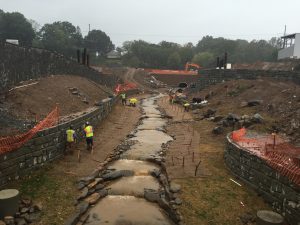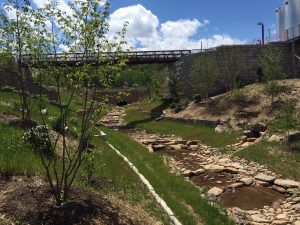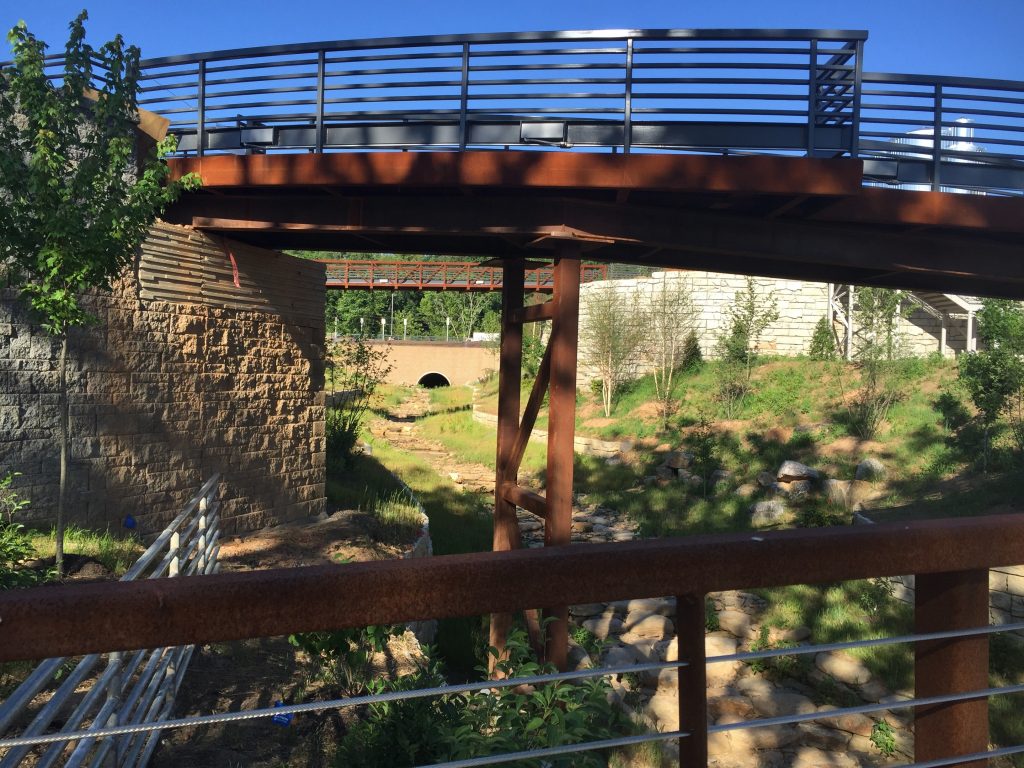Smack dab in the middle of New Belgium’s east coast brewery site is a creek that drains approximately 150 acres of West Asheville into the French Broad River. This watershed is one of the most urbanized in Asheville, so the creek experiences large swings in water levels since water runs off of urbanized surfaces much faster than if they were still forested. The stream was identified for restoration as an opportunity for the City of Asheville to address water quality issues contributing to the French Broad and in doing so, was designed so that New Belgium could celebrate it as a central feature on their site. Equinox worked with Wolf Creek Engineering to complete the design.

Equinox Landscape Designer Megan Foy recalled “at one of the first site visits we did with Wolf Creek Engineering we approached the stream corridor and could find no water”. Not only was the existing five foot culvert under Craven Street choked down to only about a foot due to sedimentation, the stream disappeared into a hole in the ground which indicated just how much debris must exist subsurface. How do you design a stream restoration when the stream disappears below ground? The actual design of the channel was somewhat complicated by this fact, along with the narrow channel width, facilities and active use areas being constructed adjacent to its banks, and wall systems that were needed to achieve the adjacent uses of the site. One innovative technique, for example, involved the installation of membrane “curtains” upstream of each boulder in-stream structure, forcing the sub-surface water to the surface, and to spill over the boulders. Overall, a great deal of thought and detail went into the design of the stream restoration which was later dubbed Penland Creek.
 The goal of the stream improvement was to re-establish the ecological function of the creek prior to being released into the French Broad River. Despite the challenge of the remaining area we had to work in, Fred Grogan, Landscape Architect and stormwater expert at Equinox commented that “we were able to achieve implementation of a functional, stylized stream corridor complete with in-stream structures, native plantings and a floodplain bench.” The design includes a series of ledges which function naturally to dissipate the energy of the water. Small curvilinear walls flank the stream defining the floodplain bench which help reduce the vertical element of the side slopes, allowing the bench to widen. This enabled the stream to “breathe” by providing it the room to naturally spread out during high water events, reducing the erosive potential typically resulting from constrained channels. Intentional breaks in these walls were carefully aligned with the in-stream structures creating the illusion these structures are actually a part of a larger bedrock vein.
The goal of the stream improvement was to re-establish the ecological function of the creek prior to being released into the French Broad River. Despite the challenge of the remaining area we had to work in, Fred Grogan, Landscape Architect and stormwater expert at Equinox commented that “we were able to achieve implementation of a functional, stylized stream corridor complete with in-stream structures, native plantings and a floodplain bench.” The design includes a series of ledges which function naturally to dissipate the energy of the water. Small curvilinear walls flank the stream defining the floodplain bench which help reduce the vertical element of the side slopes, allowing the bench to widen. This enabled the stream to “breathe” by providing it the room to naturally spread out during high water events, reducing the erosive potential typically resulting from constrained channels. Intentional breaks in these walls were carefully aligned with the in-stream structures creating the illusion these structures are actually a part of a larger bedrock vein.
The restoration was also intended to provide both visual and audible interest. Specific features of the stream were intended to be located in such a way that people experiencing it would be able to view and hear the water. Critical locations for such in-stream structures were designed at bridge crossings to maximize this experience. Specifically, one of the more significant drop pool sections was located so that a user would be able to hear it while viewing the rest of the upstream section at an intentional angle from the greenway bridge. Reflecting on design intent, Fred commented that “it is always our intention to anticipate user experience, and it is particularly rewarding to experience standing on that intended vantage point”. A bridge within the NBB site was also anticipated to help enframe this view.

